Bibimbap is a traditional Korean rice dish that is served topped with meat and assorted vegetables then mixed with a spicy gochujang sauce. The combination of spicy, savory and slightly sweet flavors with a variety of textures that come from different vegetables and meat makes this one of the most popular Korean dish all over the world.
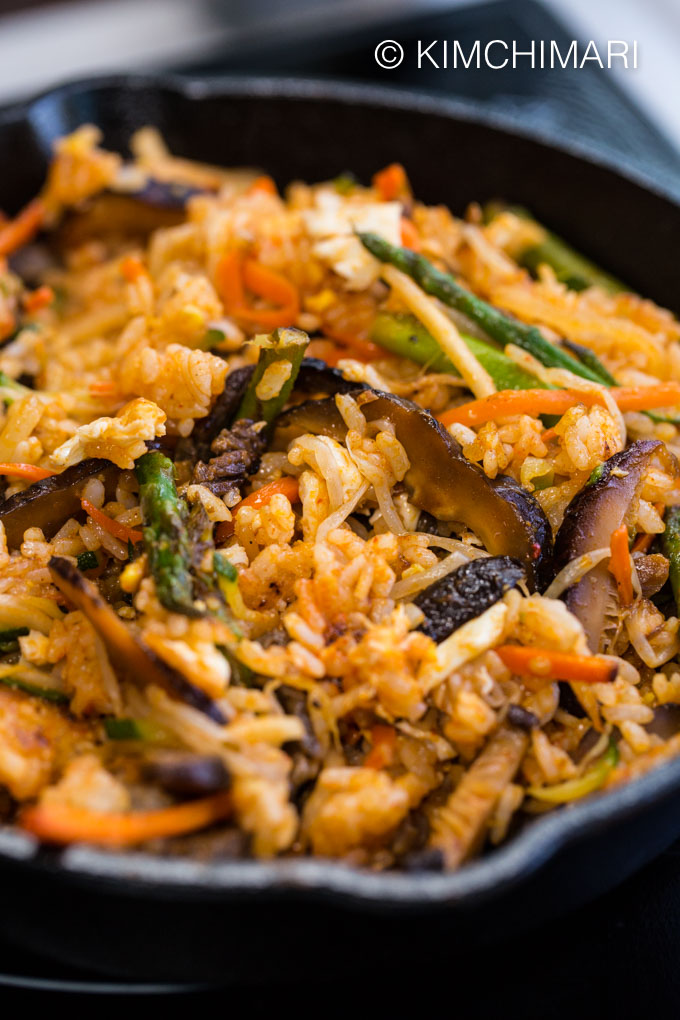
As a child, I was not a fan of bibimbap… because I thought there were too many chewy vegetables like kongnamul (soybean sprouts), gosari (fiddleheads) and doraji (bellflower roots)…and I think I choked on those stringy veggies at least 3 times!! 😰😵HAHAHA… sooo… we were not the best of friends when I was little.
I told mom many times — I didn’t like it but because in a family of 7, everyone else enjoyed it, I was totally ignored. So sometimes I would just pick out the extra chewy veggies and eat only the softer ones. So if you have little kids, please make sure the vegetables are cut in smaller pieces because it may not be all well chewable. 😉
But I’ve grown to really love this unique Korean dish that is now so popular all over the world.
Table of Contents
What is Bibimbap?
Bibimbap was traditionally also called Gol-dong-ban 골동반 in Hanja which means to mix until you get dizzy..haha.. But simply, bibim literally means ‘to mix’ and bap means ‘rice’. So it means ‘mixed rice’ when you just look at the words but what it refers to are bowls of rice that are first served, topped with various vegetables and some kind of seasoned meat or seafood.
It can be served hot or at room temperature. When you mix the rice, you will want to add bibim gochujang sauce to make it even more delicious.
What makes Bibimbap so good?
Let me answer that question with a question – What makes a salad so good? 😝😝
I think I would say it’s the same reason. When you eat a salad, you get all the different flavors and textures of fresh greens, nuts, sweet tomato and sometimes onions – all in a mouthful and the salad dressing wraps it all together. Korean bibimbap is basically a salad of rice, different flavors and textures of vegetables and meats all dressed in the amazingly fabulous gochujang sauce.
There is a hint of sweet, bitter, sour, smoky, earthy and rich meaty flavors in every bite.
What makes my recipe traditional and authentic?
To me, traditional and authentic Korean bibimap has at least some if not all of the following traditional namul or Korean vegetables (note, this is just a very basic partial list). It also has to do with the colors, it is good to serve 5 different colors – white, black(brown), green, red and yellow:
Making a proper, traditional version takes quite a bit of work and time. Now, if you want a more simplified, quick version with more easy to find vegetables (and not having to make a trip to the Korean store) and one that tastes just as good, you can check out the toppings I use for Dolsot Bibimbap. You don’t have to use a stone pot but you can totally follow the list of toppings I use there.
FYI, the toppings usually represent the unique produce of each province in Korea and so the toppings will be different based on the area you are in. The typical one you get in Seoul usually includes 3-4 different edible wild greens (나물 Namul), some common vegetables such as carrots, spinach, soybean sprouts, radish and then some meat (beef, chicken) or seafood (squid, shrimp). But if you were to go visit the mountain regions, you are bound to have Sanche Bibimbap which has lots of mountain greens.
Cook’s Tips for Perfect Bibimbap
- Cook Rice with less water – dry rice makes better bibimbap because otherwise, the final mixture may come out too soggy
- Texture of vegetables is important for bibimbap- you can substitute other vegetables but try to have a variety of soft, chewy and even crunchy if you can.
- Instead of bellflower roots and spinach, you can also make these: radish namul and perilla namul.
- Sprinkle some roasted sea laver pieces as a final garnish.
- Serve with some gochujang and sesame oil to add to taste. Mix everything and enjoy.
- Make gochujang bibim sauce – 1 Tbs gochujang + 1 tsp rice vinegar + 1 tsp honey. Use this instead of plain gochujang for a little more tang and sweetness.
- Gochujang can overpower your bibimbap so use less than more. One thing with adding too much gochujang is that you can’t really fully taste all the different ingredients. So start by adding a little bit of gochujang (1 tsp) and then increase gradually.
- Typical 6 toppings –
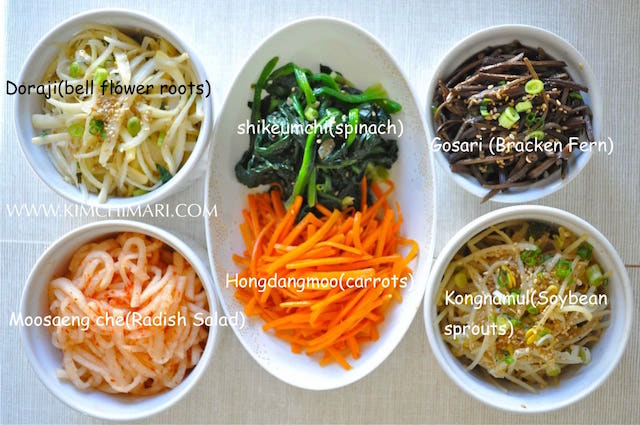
Above is a picture of the 6 different kinds of vegetable toppings(namul) for a very traditional recipe. Beef is missing in the picture.
Step-by-Step Directions
Prep Time: 6 hrs Cooking Time: 1 hr 15 min Servings: 2 Difficulty: Medium
- Seasoned Ground Beef
- Prepare ground beef by mixing in all the seasonings and then sautéing beef on medium heat until fully cooked. Set aside.
- Sauteed Bellflower Roots (Doraji 도라지) – I have a separate full post on this HERE.
Doraji are the roots of a bellflower plant that adds a great chewy texture to bibimbap. It’s also called balloon flower and platycodon.
- Doraji is usually sold dried. If your store sells the reconstituted ones buy it! If not, soak the dried roots in water overnight and drain. Rub the roots with rough sea salt to extract some of the bitterness.
- Split and cut doraji roots into approx 2 in long and 1/8 in thick pieces. See the picture above for how you can split a whole root (top left) and then split each into even thinner pieces (top right) – by inserting a small knife upside down (with the blade side up) and then pushing it upwards. Be careful though – make sure you point the knife AWAY from you or anyone you like.. 🙂 Wash and rinse the cut doraji roots and drain.
- Heat vegetable oil in a frying pan. Saute doraji and chopped garlic on medium heat. Sprinkle 1/2 tsp salt. Saute for 3-4 minutes until the doraji pieces are tender yet still a bit crunchy. Turn off the heat, sprinkle green onions and sesame oil. Set aside.
You can eat doraji raw so don’t worry about not cooking it enough. It’s all about having the right texture (should be slightly chewy and crunchy) and the right amount of seasoning. Adjust salt to taste – keep it on the lighter side because additional seasoning will be added to the final dish.
NOTE – when you taste doraji while it’s hot/warm, it will taste quite bitter. Don’t worry..the bitter taste will mostly go away once it cools. But remember that it is supposed to taste still slightly bitter as it belongs to the ginseng family.
- Blanched Spinach (Shikeumchi Namul 시금치 나물)
- Korean spinach are more firm and fibrous than American spinach. Here’s how it looks –
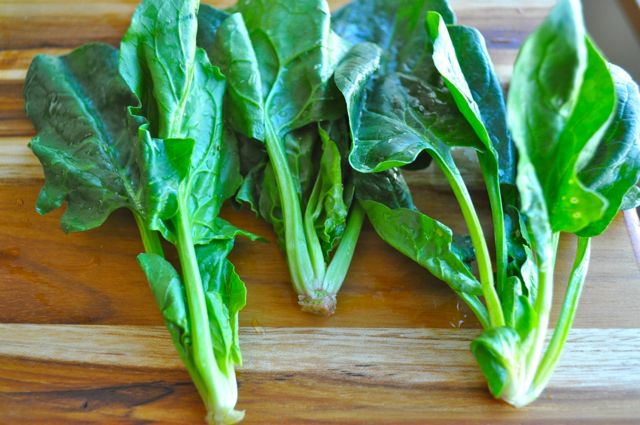
korean spinach for bibimbap - Boil a pot of salted water (6 C or so + 1 tsp salt) and quickly blanch the spinach. Do not cook spinach more than 1 minute. Spinach should be still a bit chewy and not mushy. Shock the cooked spinach in cold or ice water to stop the cooking process.
- Drain the water and squeeze out any excess water from the spinach by squeezing them gently in your hand.
- Season the blanched spinach with some salt (1 tsp) and sesame oil (1 tsp). Set aside.
- Korean spinach are more firm and fibrous than American spinach. Here’s how it looks –
- Bracken Fiddleheads (고사리 나물 Gosari/Kosari Namul)
- If using dried Gosari (go to Gosari Namul recipe post for more details). Gosari is one of my favorite namul!
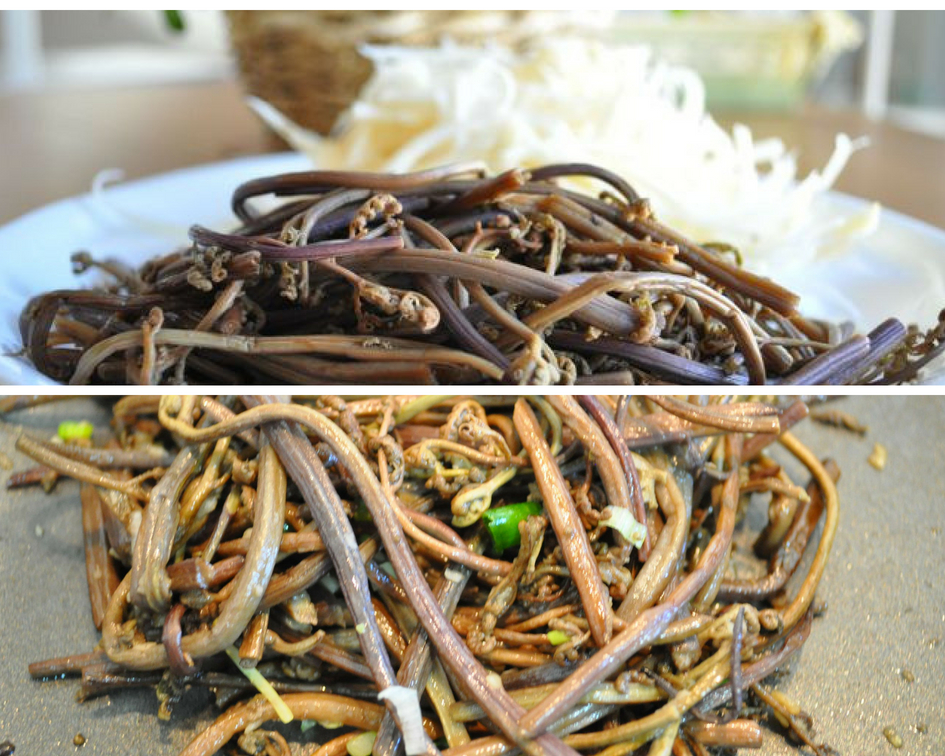
Bracken Fiddle Heads (gosari) reconstituted and sauteed - Boil it for 20 – 30 minutes until they are soft then drain. Soak in cold water for 6-8 hours to draw out any bitterness.
- Trim the reconstituted Gosari by going through each piece and cutting off any hard stems.
- Cut them into bite size pieces (2 in long)
- Heat vegetable oil in a frying pan on medium heat. Saute Gosari and chopped garlic. Sprinkle 1/2 tsp salt and Guk Ganjang (Korean Soup Soy Sauce). Saute for 5 minutes on low heat. Turn off the heat, sprinkle green onions and sesame oil. Set aside.
- If using dried Gosari (go to Gosari Namul recipe post for more details). Gosari is one of my favorite namul!
- Radish Salad (무생채 나물 Moo Saeng Che Namul)
- See my Korean Radish Salad recipe for detailed recipe. Same recipe is also listed below. You only need a little bit for bibimbap so I reduced the ingredients by half.
- Sauteed Carrots (홍당무 Hongdangmoo)
- Heat frying pan with oil on medium heat. Add julienned carrots and a pinch of salt. Saute carrots until they are soft and tender. Adds great sweetness and color!
- Cooked Soybean Sprouts (콩나물 Kongnamul)
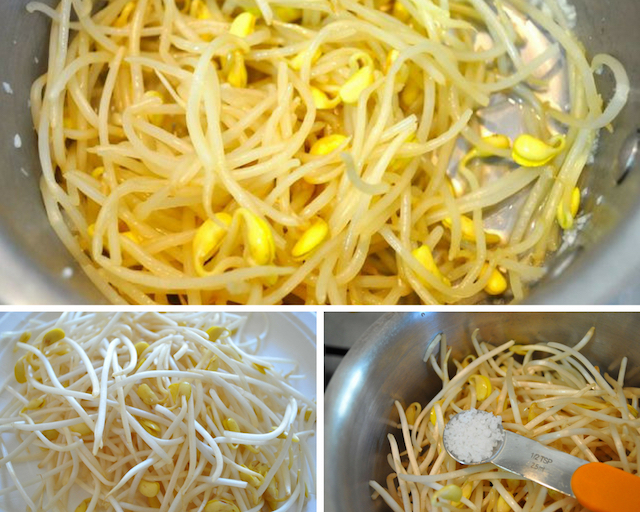
- Wash and clean the soybean sprouts (left bottom). Optionally break off the root ends if they are brown.
- In a small pot, add water, soybean sprouts, salt and garlic (right bottom). Bring to a boil and let it simmer for 8 minutes or so until most of the water has evaporated. Remember the sprouts may taste fishy if you open the lid during cooking. It’s good if you can use a clear glass lidded pot so you can see it without opening the lid.
- Turn off heat and sprinkle sesame oil and sesame seeds. Set aside (top).
How to cook the Egg
Most swear by having a runny egg on top as the last topping.
Fry the egg sunny side up or over easy so the egg yolk is still runny. If you don’t like it that way, you can certainly cook the egg all the way or even scramble it. Fully cooking the egg will not give you the rich yolk taste but it can also make the bibimbap taste lighter and drier which some people may prefer.
How to Assemble
Put rice at the bottom of a bowl to start your bibimbap. Here I’ve used plain rice but you can use brown rice too.
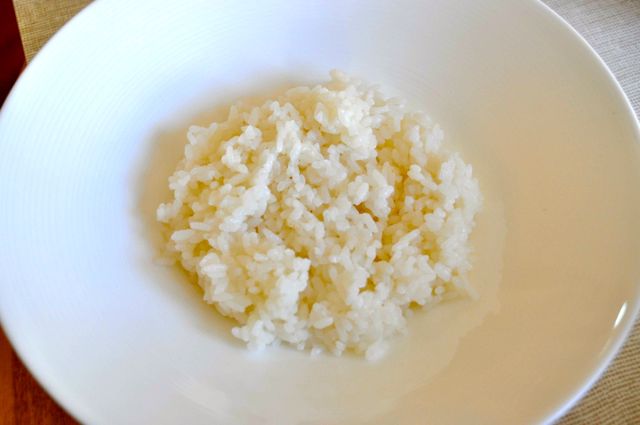
Top rice with vegetables and then ground beef in the middle. Don’t you just love the colors??
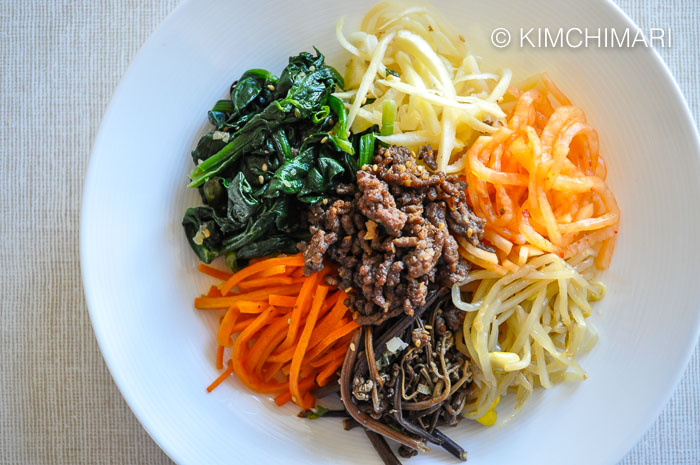
Add the fried egg on the very top and serve with gochujang and sesame oil so each person can season to their taste. Mix it all up and there you go!
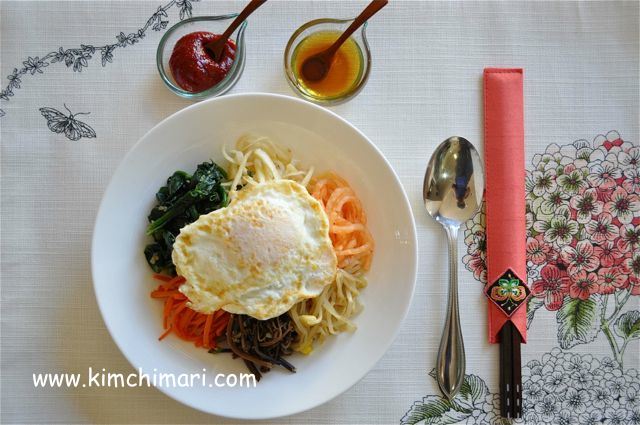
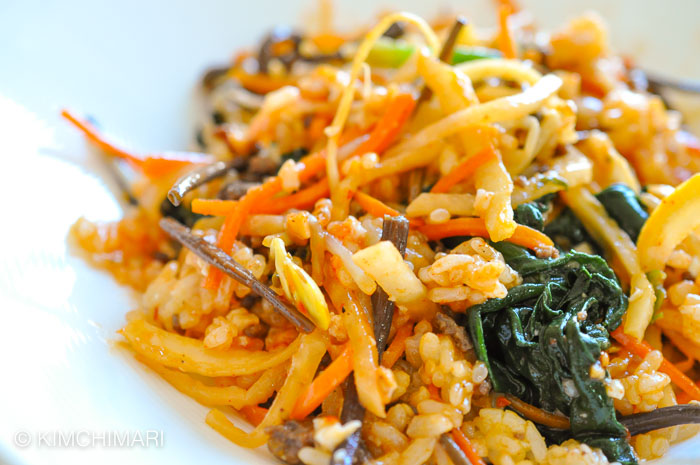
Different Bibimbap Variations
Every bibimbap recipe will have an array of vegetables and meat toppings but they have different names depending on either what the protein is or what region it comes from. I list only the front part of the name, so for e.g. it will be Jeonju Bibimbap.
- Sogogi 소고기 비빔밥 (Beef) – beef slices or ground beef is seasoned and cooked, also called bulgogi bibimbap if bulgogi meat is used
- Yukhoe 육회 비빔밥 (beef tartar) – Korean style raw beef tartar seasoned lightly
- Haemul 해물 비빔밥 (Seafood) – some combination of seafood, usually squid, shrimp or oysters
- Sanche 산채 비빔밥 (Mountain vegetables) – different mountain greens (san namul) are added as vegetables
- Jeonju 전주 비빔밥 – this famous variation comes from the region of Jeonju which is known for delicious food. This version always has Kongnamul (soybean sprouts), Yukhoe (beef tartar) and raw egg yolk on top. The rice is also cooked in beef broth which makes it unique.
- JinJu 진주비빔밥 – coming from the city of Jinju (also my name!) this one is also topped with Yukhoe but there is no egg yolk and the vegetables are steamed not sauteed in oil.
What to serve together
Serve it with some clear soup like Soybean Sprout Soup (Kongnamul Guk), Dried Pollock Soup(Bugeo Guk) or Seaweed Soup(Miyeok Guk). Also, some fresh side dish of Kimchi is a must.
What if I cannot get the special Korean vegetables for Bibimbap?
Here’s my Dolsot Bibimbap video — you can watch it to see how you can also make it with easier to get ingredients like Asparagus and Zucchini instead of the traditional Korean namul listed above. It may not be as traditional but it will still be delicious!
BON APPETIT! ❤️
XOXO,
JinJoo
☆ Did you make this recipe? I hope you can give me a 5 star rating below!
And leave me a comment to let me know how you like it! I’d LOVE to hear from you! 😍
You can also FOLLOW ME on FACEBOOK, PINTEREST and INSTAGRAM or join my FACEBOOK GROUP to see, ask and share everything about Korean food with others just like you!
UPDATE NOTES – This recipe was originally published Nov 2012 but was re-published with update information and more cooking tips in July 2018 and Sept 2019.
Bibimbap Recipe – Korean Mixed Rice with Vegetables and Meat
Ingredients
- 2 C short grain rice
Ground Beef Seasoning
- 1/3 lb ground beef
- 2 tsp soy sauce
- 1 tsp sugar
- 2 tsp rice cooking wine
- 1 tsp sesame oil
- 1 tsp minced garlic
- 1/8 tsp garlic powder (optional)
- 1/8 tsp ground black pepper
Bellflower Roots (Doraji Namul)
- 4 oz reconstituted bellflower roots (도라지 / doraji) (about 2 1/2 C or 625 ml)
- 1/2 tsp vegetable oil
- 1/2 tsp Sea Salt (Trader Joe's)
- 1/2 tsp chopped garlic
- 1/4 tsp chopped green onions
- 1/4 tsp sesame oil
Spinach
- 1 bunch spinach (washed)
- 6 C water
- 2 tsp salt
- 1 tsp sesame oil
Bracken Fiddleheads (Gosari Namul)
- 4 oz reconstituted bracken fiddleheads (about 2 C or 500 ml)
- 1/2 tsp vegetable oil
- 1/4 tsp Sea Salt (Trader Joe's)
- 3/4 tsp gook kanjang
- 1/2 tsp chopped garlic
- 1/4 tsp chopped green onions
- 1/4 tsp sesame oil
Radish Salad (Musaengche)
- 3 C julienned Korean radish (무 / moo)
- 2 tsp Sea Salt (Trader Joe's)
- 3 1/2 tsp sugar
- 3 1/2 tsp rice vinegar
- 2 1/2 tsp Korean red pepper powder (고추가루 / gochugaroo)
Carrots
- 1 large carrot or 2 small carrots julienned (about 1 C / 250 ml)
- pinch of salt
- 1 Tbsp vegetable oil
Soy Bean Sprouts (Kongnamul)
- 3 C soybean sprouts
- 1/2 tsp Sea Salt (Trader Joe's)
- 1/2 tsp chopped garlic
- 1/2 tsp sesame oil
- 1/3 C water
Fried Egg
- 1 egg pan fried, over easy/medium/scrambled
Condiments
- 2 tsp gochujang adjust to taste
- 1-2 tsp sesame oil
Bibim Gochujang Sauce
- 1 Tbsp gochujang
- 1 tsp rice vinegar
- 1 tsp honey or more to taste
Instructions
- Prepare ground beef by mixing in all the seasonings and then sauteeing beef on medium heat until fully cooked. Set aside.
How to prepare Bell Flower Roots (Doraji Namul)
- Doraji is usually sold dried. If your store sells the reconstituted ones buy it! If not, soak the dried roots in water overnight and drain. Rub the roots with sea salt to extract some of the bitterness.
- Split and cut doraji roots into approx 2 in long and 1/8 in thick pieces by inserting a small knife upside down (with the blade side up) and then pushing it upwards. Wash and rinse the cut doraji roots and drain.
- Heat vegetable oil in a frying pan on medium heat. Saute doraji and chopped garlic. Sprinkle 1/2 tsp salt. Saute for 3-4 minutes until the doraji pieces are tender yet still a bit crunchy. Turn off the heat, sprinkle green onions and sesame oil. Set aside.
Blanched Spinach (Shikeumchi Namul)
- Boil a pot of salted water (6 C or so + 1 tsp salt) and quickly blanch the spinach. Do not cook the spinach more than 1 minute. Spinach should be still a bit chewy and not mushy. Shock the cooked spinach in cold or ice water to stop the cooking process.
- Drain the water and squeeze out any excess water from the spinach by squeezing them gently in your hand.
- Season the blanched spinach with some salt (1 tsp) and sesame oil (1 tsp). Set aside.
Sauteed Bracken Fiddleheads (Gosari/Kosari Namul)
- Boil it for 20 – 30 minutes until they are soft then drain. Soak in cold water for 6-8 hours to draw out any bitterness.
- Trim the reconstituted Gosari by going through each piece and cutting off any hard stems.
- Cut them into bite size pieces (2 in long)
- Heat vegetable oil in a frying pan on medium heat. Saute Gosari and chopped garlic. Sprinkle 1/2 tsp salt and gook kanjang. Saute for 5 minutes on low heat. Turn off the heat, sprinkle green onions and sesame oil. Set aside.
Radish Salad (MooSaengChe Namul)
- See my Korean Radish Salad recipe for detailed instructions. You only need a little bit for bibimbap so I reduced the ingredients by half for this recipe.
Sauteed Carrots
- Add 1 T oil in frying pan on medium heat. Add julienned carrots and a pinch of salt. Saute carrots until they are soft and tender.
Soybean Sprouts (Kongnamul)
- Wash and clean the soybean sprouts. Optionally break off the root ends if they are brown.
- In a small pot, add water, soybean sprouts, salt and garlic. Bring to a boil and let it simmer for 8 minutes or so until most of the water has evaporated. Remember the sprouts may taste fishy if you open the lid during cooking. It’s good if you can use a clear glass lidded pot so you can see it without opening the lid.
- Turn off heat and sprinkle the sesame oil. Set aside.
Pan Fried Egg
- Usually the egg is fried over easy so the egg yolk is still runny.
How To Assemble Bibimbap
- In a bowl, about 1 cup cooked rice, top with each of the vegetables and the beef in the middle. Top with fried egg. Serve with gochujang and sesame oil.
Tips & Notes:
- Cook Rice with less water - dry rice makes better bibimbap because otherwise the final mixture may come out too soggy
- Balance the texture of vegetables - you can substitute other vegetables but try to have a variety of soft, chewy and even crunchy if you can
- Make Gochuajng Bibim Sauce with 1 Tbs gochujang + 1 tsp rice vinegar + 1 tsp honey. It adds a little more tang and sweetness which makes bibimbap even more delicious!
- Many Koreans add a lot of gochujang and make it really red and spicy. I personally don’t like it that way because you can’t really fully taste all the different ingredients. So start by adding a little bit and then increase gradually.
- Sprinkle some roasted sea laver pieces as a final garnish.

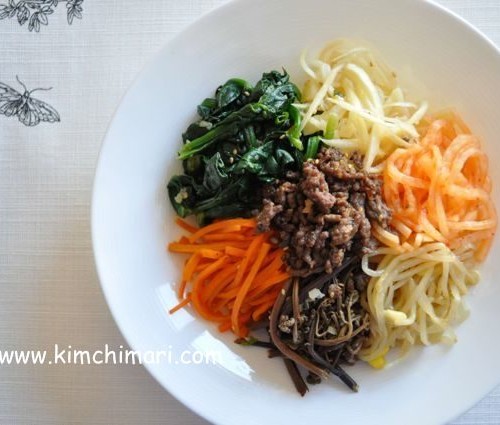

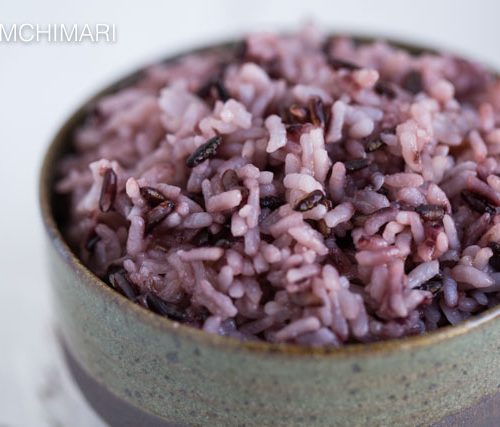
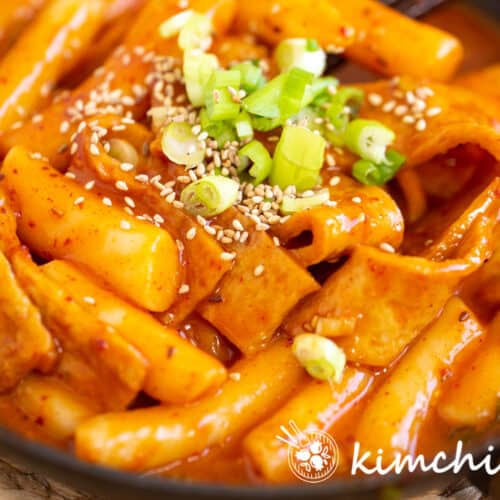
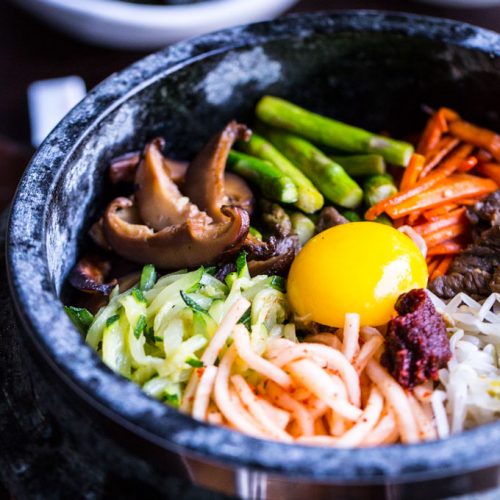
















another winner! I’ve been craving 비빔밥 for a while now. I used your general method, though I changed my ingredients to match what I could get/already had, so I made the ground beef topping (with Impossible ground meat — but I’m sure it’s even better with the real thing!), the carrots, and then did various sides of zucchini (sauteed in sesame oil with green onion, garlic and 참치액), sweet red and yellow bell peppers (sauteed in perilla oil with garlic, added crushed sesame seeds after cooking) and for greens, I combined rehydrated cooked 취나물, spinach and a bit of kale and cooked it all as you do for greens. very delicious! I love your gochujang sauce — it’s just right.
Thank you so much Diane for trying another recipe!! Yes, the beauty of bibimbap is that you can basically use whatever veggies or meats you have and make it. Your combination sounds delicious. Appreciate your comments so much. Please keep them coming!
I read through your versions of bibimbap and I think it will serve as a reliable reference for my children. Thank you
I’m so glad to hear that. Thank you.
Perfect introduction to Korean food. Perfect recipe for beginners! Easy to make and assemble.
thank you! I’m glad it was easy to make for you!
Bookmarked this recipe.
Thank you for sharing. 🙂 <3
Easy to make… the beef marinate was delicious! I tried this for dinner today and it was nice. I didn’t make all the dishes though. I shall try again next time, but I’d like to remove the rice vinegar in the bibimbap sauce, as I don’t like the vinegar-ish smell… is there any recommendations to substitute the vinegar? Thanks for sharing this recipe!
That’s so awesome to hear! You can totally not add vinegar or sugar to the bibimbap sauce and just enjoy adding gochujang only with some sesame oil. Or you can substitute vinegar with lemon juice if you’d like. Good luck!